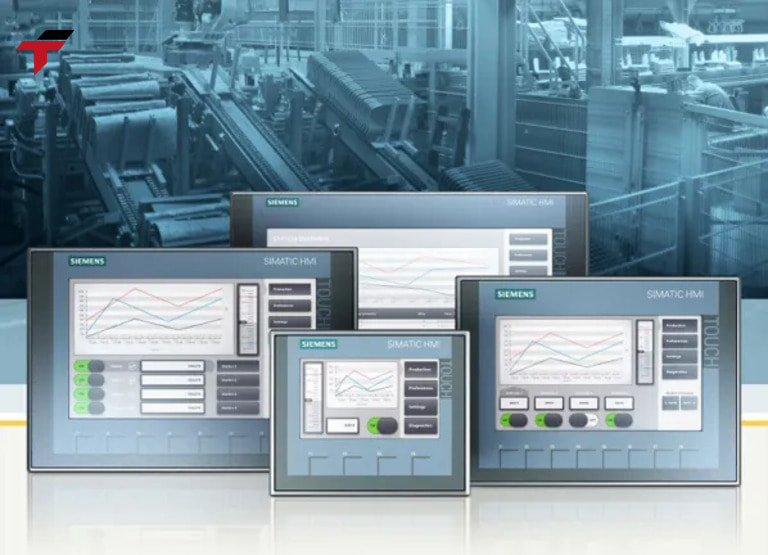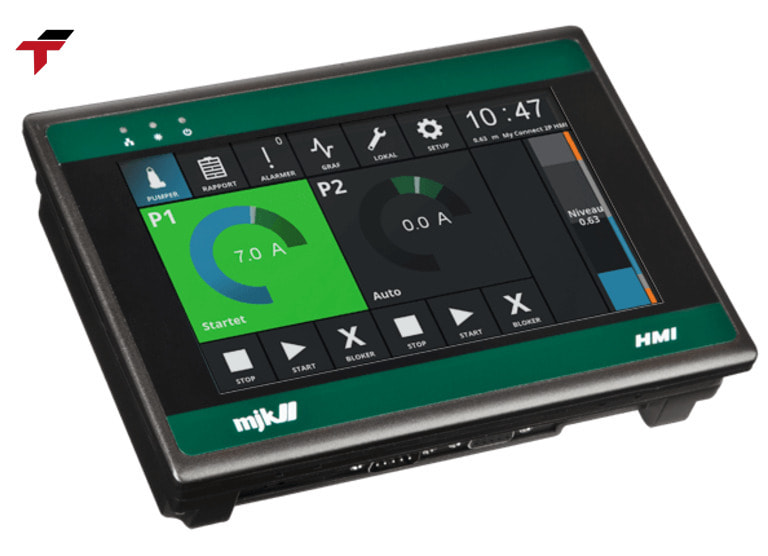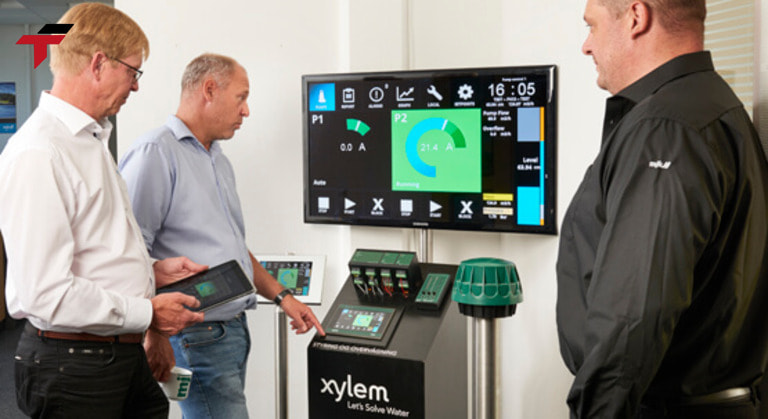In industrial automation, the HMI Alarm Function plays a crucial role in maintaining system safety and minimizing downtime. It enables real-time monitoring, immediate alerts, and efficient troubleshooting whenever abnormal conditions occur. Through this article, Flextech shares in-depth insights into how the HMI Alarm Function works, how to install and configure it properly, and key design considerations to ensure your production line operates reliably and efficiently.
What is HMI Alarm Function?
An Alarm Function in HMI (Human Machine Interface) is a built-in mechanism that detects abnormal states or equipment failures and alerts the operator. When operating parameters exceed predefined limits (such as temperature, current, or pressure), the HMI automatically displays a warning — allowing engineers to react quickly and prevent further damage.
Acting as a 24/7 monitoring assistant, the HMI Alarm Function helps:
- Detect system failures immediately and reduce potential damage.
- Shorten unplanned downtime and improve production continuity.
- Enhance operational safety and protect valuable assets.
How does Alarm in HMI work?
For the warning system to work effectively, HMI Alarm Function follows a specific process. Below are 5 basic steps to help you visualize how it works.
Step 1: Monitor input signals
The HMI or PLC continuously collects real-time data from various field devices such as temperature sensors, pressure transmitters, flow meters, or current sensors.
Each of these devices sends analog or digital signals to the controller. The system then compares the actual values with predefined thresholds or setpoints that represent safe operating ranges.
This continuous data acquisition forms the foundation of the alarm system — ensuring that any deviation from the normal range can be detected within milliseconds.
Step 2: Detect alarm conditions
Once the measured value goes beyond the acceptable limit (either too high or too low), the system immediately identifies this as an alarm condition. Depending on the control structure:
- In some systems, the PLC handles all logical detection and sends alarm triggers to the HMI via communication protocols like Modbus TCP, Ethernet/IP, or Profinet.
- In others, the HMI directly performs comparison logic, especially in smaller systems or standalone configurations. This process ensures that the HMI is always aware of equipment status and can respond as soon as abnormal data is detected.
Step 3: Activate the alarm on the HMI screen
Once the alarm condition is detected, the HMI immediately activates a visual and/or audible alert to notify the operator. Typical alarm display methods include:
- Color change on-screen indicators (e.g., turning from green to red).
- Flashing alarm icons or text messages describing the issue.
- Audible buzzers or sirens to ensure visibility even in noisy environments. Some advanced HMI models also allow customized alarm behaviors, such as sending emails, text messages, or triggering external warning lights through digital output.
This instant feedback helps the operator identify the problem source quickly and take corrective actions without delay.
Step 4: Record alarm history log
Every alarm event is automatically logged into the HMI’s internal memory or a connected database. The alarm log usually includes:
- Alarm ID and name.
- Time of occurrence and acknowledgment.
- Alarm status (active, acknowledged, cleared).
- Operator who confirmed or reset the alarm. This historical alarm data is crucial for maintenance and quality control. It allows engineers to analyze recurring issues, evaluate operator response time, and improve future alarm configurations to prevent similar events.
Some HMI systems even support data export to CSV or SQL servers, making it easier to integrate with reporting tools for performance analysis.
Step 5: Send Alarm data to SCADA (if available)
In modern industrial networks, HMI alarms are not limited to local display. When connected to SCADA (Supervisory Control and Data Acquisition) systems or centralized monitoring software, the HMI can automatically transmit alarm data over Ethernet or industrial networks.
This enables remote supervisors or maintenance engineers to:
- View real-time alarm status from control rooms or via web access.
- Analyze multiple HMI units from a single monitoring interface.
- Coordinate maintenance or emergency responses more effectively.
Integration between HMI and SCADA ensures complete transparency and visibility across the production line — a critical factor for large-scale operations that rely on uptime and precision.

Below are 5 basic steps to help you visualize how it works
What are the common types of Alarms in HMI?
For the alarm system to operate effectively and easily manage, HMI often divides Alarms into 4 different types. Each type will be suitable for its own purpose and priority level.
Instant Alarm
This is the most common and critical type of alarm. It is triggered immediately when an abnormal condition is detected — such as:
- Motor overload or overheating
- Temperature, pressure, or level exceeding predefined limits
- Loss of signal from sensors or communication failure with PLC
When an instant alarm is activated, the HMI screen will display a clear visual notification (e.g., flashing icons, red highlights, or pop-up windows) and may also activate sound alerts. This ensures operators can detect the problem as soon as it occurs and take corrective action to minimize downtime or equipment damage.
Historical Alarm
Every alarm event that occurs in the system is automatically recorded in the HMI’s internal memory or external storage. The log includes key details such as:
- Alarm name or type
- Time and date of occurrence
- Operator acknowledgment and resolution status
- Duration and frequency of recurrence
This database plays a vital role in root cause analysis and predictive maintenance. Engineers can review past alarms to detect patterns, identify recurring issues, and make data-driven improvements to the process or equipment.
Group Alarm
In large-scale automation systems, the number of alarms can be overwhelming. To simplify monitoring, alarms are grouped logically based on machine type, production zone, or system function.
For example:
- Motor Alarm Group: Motor overload, bearing temperature, phase loss
- Pump Alarm Group: Low suction pressure, dry running, motor current overload
- Temperature Alarm Group: High/low temperature deviation across sensors
- By grouping alarms, the HMI allows operators to quickly identify which part of the line is affected, prioritize responses, and assign responsibilities efficiently.
Sound/light alarm
To enhance operator awareness, especially in noisy or high-traffic environments, the HMI can trigger external alarm indicators such as:
- Buzzers or sirens
- Rotating beacon lights
- Flashing tower lights
These alarms are particularly useful when the HMI screen is not constantly monitored. The combination of visual and audible signals ensures no critical event is overlooked, improving both response speed and workplace safety.

Alarms into 4 different types. Each type will be suitable for its own purpose and priority level.
What are the benefits of using the HMI Alarm Function?
Equipping the Alarm feature on the HMI brings many important benefits for both operation and maintenance. Below are the outstanding values that HMI Alarm Function brings to businesses.
- Detect incidents quickly, reduce downtime: The warning feature helps engineers or operators detect incidents as soon as they arise, thereby handling them promptly, limiting widespread damage and reducing unplanned downtime.
- Increase safety during operation: HMI Alarm Function acts as an automatic monitoring system, detecting dangerous conditions such as high temperature, pressure exceeding the threshold, etc.
- Support for error cause analysis (Alarm History): Thanks to the alarm history storage feature, engineers can easily retrieve, compile statistics and analyze incidents that have occurred, thereby finding the root cause and providing more effective preventive solutions.
- Easy integration with SCADA, remote monitoring system: HMI’s Alarm Function can be easily synchronized with SCADA system or central monitoring software, helping engineers monitor remote alarm status, proactively handle problems without having to be directly present at the machine.
What should be noted when designing & installing Alarm?
For the alarm system to operate stably and effectively, engineers need to note some important points when designing and installing Alarm for HMI.
- Avoid false alarms (Alarm noise): False alarms or continuous false alarms can easily cause operators to ignore really important alarms. Set clear Alarm conditions, use noise filters or activation delays if necessary.
- Set reasonable priority and Alarm groups: In large production lines, there are many Alarms. Grouping by area, equipment type and setting priority levels (emergency level, monitoring level, etc.) helps engineers focus on handling serious errors first.
- Arrange the Alarm interface for easy observation: The Alarm display screen needs to be arranged scientifically, with recognizable colors and clear icons so that operators can immediately understand what needs to be handled.
- Ensure that Alarm data is stored securely: Check the Alarm History saving feature periodically. Back up data to avoid losing logs when power is lost or hardware failure occurs. This is especially important when tracking complex incidents.

For the alarm system to operate stably and effectively, engineers need to note some important points when designing and installing Alarm for HMI.
Conclusion
The HMI Alarm Function plays an essential role in maintaining stability, safety, and efficiency across modern automation systems. By enabling early detection of abnormalities and providing clear, real-time notifications, this feature allows operators to take timely corrective actions – minimizing downtime and preventing costly equipment failures.
To fully leverage the benefits of HMI alarms, engineers should design alarm structures scientifically: define proper thresholds, group alarms logically by importance, and ensure that all event data is securely recorded for analysis. A well-configured alarm system is not just a monitoring tool.
At Flextech, we specialize in providing comprehensive automation solutions — from HMI configuration and PLC integration to complete monitoring and alarm systems. Our goal is to help businesses optimize operational reliability, enhance safety, and reduce maintenance costs through intelligent control design and data-driven engineering.


